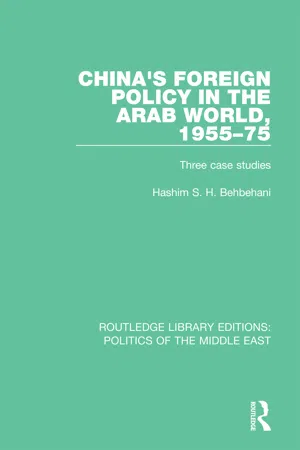
China's Foreign Policy in the Arab World, 1955-75
Three case studies
- 442 pages
- English
- ePUB (mobile friendly)
- Available on iOS & Android
About This Book
China's foreign policy in the Arab world is important because it reflects China's general foreign policy. In this study, first published in 1981, the author draws upon a wealth of previously unpublished and inaccessible material to analyse Chinese attitudes in three cases: the two Arab liberation movements, the Palestine Resistance Movement and the Popular Front for the Liberation of the Oman, and the established and independent State of Kuwait. Since the Arab liberation movements played a significant political role within their fields of operation, it was necessary for China to decide whether these movements did actually fit in with Chinese foreign policy objectives. Dr Behbehani's analysis of these two case studies provides the basis for a discussion of whether China's motives in supporting the liberation movements are theoretical or purely practical. China's support for Kuwait's political internal continuity is related to the stability of the whole Gulf region. The author analyses Chinese support for Kuwait and the surrounding conservative states on two main bases, political and economic, in the form of trade. It is through these channels, particularly the economic one, that China has sought to establish itself in the Gulf and the Arabian peninsula.
Frequently asked questions
Chapter 1
China and the Arab world
Table of contents
- Cover
- Half Title
- Title Page
- Copyright Page
- Original Title Page
- Original Copyright Page
- Dedication
- Table of Contents
- Illustrations
- Abbreviations
- Note on transliteration and sources
- 1 China and the Arab world
- 2 Sino-Palestinian relations 1955–66
- 3 The 1967 June War and its aftermath: developments in the Palestine Resistance Movement
- 4 Black September and its aftermath
- 5 Turning point in Sino-Palestinian relations
- 6 Brief history of the Liberation Movement in Oman
- 7 China’s attitudes to, involvement in, and withdrawal from, the Omani War, 1955–75
- 8 China and Kuwait
- Conclusion
- Appendix 1 Fatah military study on China
- Appendix 2 Arab Labour Party of Oman’s study on the historical development of Oman
- Appendix 3 PFLOAG: internal directives
- Appendix 4 Minutes of talks
- Appendix 5 Sino-Arab delegation exchanges, 1956–75
- Appendix 6 Sino-Arab trade, cultural, and friendship treaties and agreements 1955–75
- Notes
- Bibliography
- Index